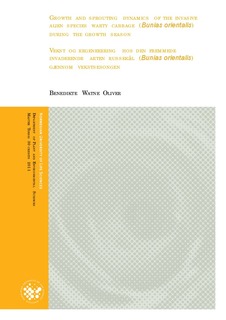| dc.description.abstract | Alien species are considered as one of the greatest drivers of biodiversity loss. In Norway Warty cabbage (Bunias orientalis L.) is considered to be a species that has a negative impact on indigenous biological diversity.
In order to eradicate an unwanted plant species as efficiently as possible it is important to take action at the stage where it is at its weakest and most vulnerable. Perennial vascular plants are weakest and prone to damage at the point in their seasonal life cycle where they have a minimum of energy stored in their below ground plant parts, called the compensation point.
In this thesis I have been studying plants of B. orientalis in order to locate a possible dry-weight minimum in the below ground plant parts, the transport direction of carbohydrate reserves by using 14C, the taproot’s ability to produce aerial shoots from adventitious buds and the time of seed ripening. The experiments were carried out from September 2009 to March 2011, and the studies were done on both young (1-2 years old) transplanted plants at Ås and on older plants sampled directly from a B. orientalis population along the E6 in Oslo.
In young plants (1-2 years old) of B. orientalis no dry-weight minimum of the below ground plant parts was found at any specific development stage, but from the isotope experiment changes in the transport direction of carbohydrate reserves were detected. At the stage where the smallest proportion of 14C was located in the roots, might be the stage where the source-sink dynamic of carbohydrate reserves shifts from the below ground plant parts being the source to being the sink, and a weak point in the species seasonal life cycle. At this point plants in their generative stage had started stem elongation and had an average height of 31 cm and inflorescence with the first individual flowers visible, but still closed. The vegetative plants had medium sized rosette with an average rosette height of 28 cm and an average diameter of 39 cm.
The young plants at Ås did not show a defined drop in their regenerative capacity from root sections at any point, but for the older plants a minimum of regenerative capacity from root sections was found at the stage where the plants had started to elongate and had an average height of 26 cm and visible inflorescence. This development stage corresponds well with the development stage found in the isotope experiment where an indication of a weak point was found.
In order to find the time of seed ripening, seeds were harvested from the roadside population in Oslo on the 6th and 20th July and on the 3rd and 17th of August. The seeds harvested in the beginning of July did not manage to germinate, while the seeds had reached maturity in the second half of July.
B. orientalis is an extremely vigorous plant with a powerful taproot which make weed control difficult, and it is therefore of great importance to monitor this species and to take action against new occurrences as soon as they are detected. | no_NO |
